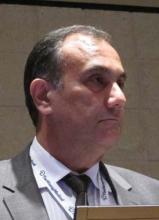ORLANDO – Home monitoring of select patients with mild, nonalcoholic acute interstitial pancreatitis is as safe as in-hospital monitoring, at a cost saving of nearly $15,000, according to a study presented at the annual Digestive Disease Week.
In a randomized controlled trial of 84 patients there were no cases of organ failure or pancreatic necrosis and no deaths within 30 days in patients assigned to either home or hospital monitoring. One patient in the home group and two in the hospital group required readmission within 30 days of discharge, reported Dr. Ali T. Ince of the Bezmialem Vakif University Medical Faculty Hospital in Istanbul, Turkey.
The total tab for home monitoring, including emergency department evaluation, intravenous therapy, and nursing visits, was $7,135, compared with $21,960 for in-hospital care, a savings of $14,825.
"Patients with mild nonalcoholic acute pancreatitis can be safely treated at home with regular visits by a nurse. Widespread adoption of this practice could result in large costs savings," Dr. Ince said.
In 2009, acute pancreatitis cases cost the U.S. health care system about $2.6 billion, for a median per patient charge of $6,096.
"The cost of severe acute pancreatitis is more than the cost of mild acute pancreatitis. However, since only 10%-15% of patients have severe acute pancreatitis, the majority of patients admitted have mild disease," he noted.
To see whether home care of such patients could be safely provided, the investigators enrolled patients admitted to the emergency department for evaluation of acute pancreatitis. Those with an Imrie scoring system value of 5 or lower, a Harmless Acute Pancreatitis Score (HAPS) of 2 or less, and a hematocrit of less than 44% were randomly assigned to either home or hospital monitoring, 42 patients in each group. All patients took nothing by mouth initially and had an oral diet gradually reintroduced.
Hospitalized patients were followed for a mean of 5 days. Home-treated patients received nurse visits on the second, third, and fifth day following discharge from the emergency department. At each home visit, nurses took vital signs, assessed symptoms, and evaluated patients’ general condition and transmitted the data to the attending physician. All patients were asked about their complaints and had physical and laboratory exams on day 7, day 14, and day 30.
Patients with organ failure, signs or symptoms of sepsis, alcoholic acute pancreatitis, prior evidence of a dilated pancreatic duct or pancreatic calcifications, coagulopathies, or comorbidities requiring hospitalization were excluded, Dr. Ince said.
All patients in each group were treated with lactated Ringer’s solution 100-150 mL/hour IV for 3 days, parenteral pantoprazole 40 mg/day, intramuscular diclofenac as needed for pain, and parenteral metoclopramide as needed for nausea, he noted.
In addition, those patients with acute biliary pancreatitis and concurrent cholangitis underwent endoscopic retrograde cholangiopancreatography (ERCP) within 12 hours of admission and received oral amoxicillin/clavulanate 875 mg/125 mg and ciprofloxacin 500 mg; they were monitored as inpatients for up to 24 hours following admission. Patients in this group who remained clinically stable with blood cultures negative for pathogenic organisms within the first 24 hours were then randomized.
All patients with acute biliary pancreatitis and an intact gallbladder underwent cholecystectomy within 6 weeks of the pancreatitis episode.
No home-monitored patients required hospitalization in the 5-7 days after discharge, and, as noted before, only one required readmission within 30 days, Dr. Ince said.
He said that the study was limited by the exclusion of alcoholic pancreatitis, which may make the results less applicable to Western nations where alcohol consumption is heavier than in Turkey. He added, however, that acute biliary pancreatitis has overtaken alcoholic pancreatitis in many Western countries, probably because of rising obesity rates.
The study was sponsored by Bezmialem Vakif University. Dr. Ince reported having no financial disclosures.


